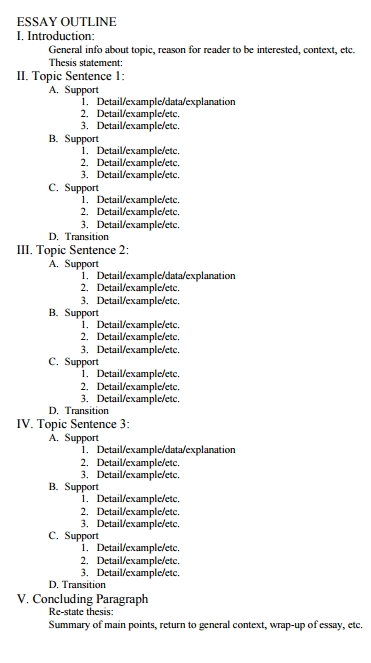
The Outline:
The outline should reveal the logic and organization of your paper. It is the "skeleton" of what will become a fully fleshed-out paper by the time you turn it in as a final draft. It is important in the outline to arrange and order both how you want to logically argue your thesis and how you want present the research results you have amassed.
By the time you are ready to make an outline of a paper, you should have done some research into your topic. The first step to constructing an outline is to take a deep breath. You're probably intimidated by the research materials and notes amassed in front of you -- not to worry.
Carefully re-read your concept paper. Try to find classifications for your findings that relate to your research question. Look for common trends. They're going to be separated from each other in your research findings, and your job is to gather them together. It doesn't really matter what your categories are for classification, as long as they clearly relate to your research question. For example, if my paper is about racism and police brutality in America, you may want to break it down into three parts: discussion of racial relations in America, investigation into the culture of policing, and examination of what makes America unique compared to other countries with respect to how racial minorities are treated by law enforcement. There are any number of other ways you could organize your paper, but be sure that it retains the logic and argument made in your thesis statement and that ultimately you answer the title question in a way that is sociological.
You can classify using a variety of techniques. If you like putting notes on index cards, then paper-clip ones that go together and shuffle them around to achieve the best order of ideas. You can also do this on the notes you take on your research findings: use different-colored symbols or highlighters or cut your sheets into strips (if you wrote on only one side of the page).
With several piles of related concepts before you, think of other ways of grouping that might make equal sense.
Once you're happy with what you've got, you may find that some sections are strong and "fleshed-out," whereas others are weaker. Do some more research where needed or see if two "weak" sections just couldn't fit under one stronger classification heading. If your points fit together, but not within the overarching argument you're making, don't be afraid to re-evaluate your question; it may just need a qualification or small change to fit the data you have collected. Your evidence may be great, but if it supports a different question, your readers won't see how great it is because they'll be expecting something else.
It will be useful to structure your outline in a particular way. Often, writers will use the basic block outline form using Roman numerals, like below:

Note the importance of providing support for your topic sentence in each body paragraph, as well as providing a transition paragraph between body paragraphs. This helps to tie your ideas together logically.
Here is some more information about outline writing from Purdue's OWL writing website.
please click the Back button on your browser to return to the previous page